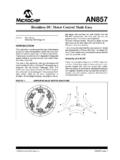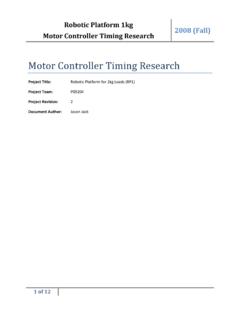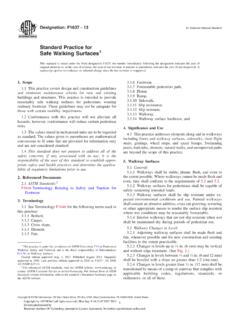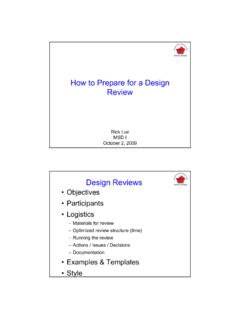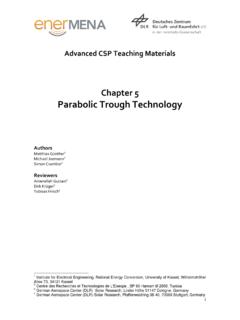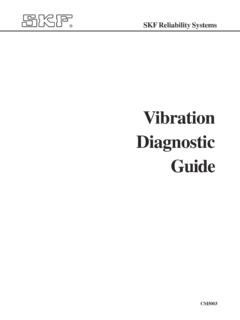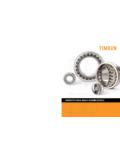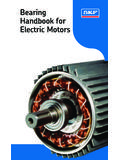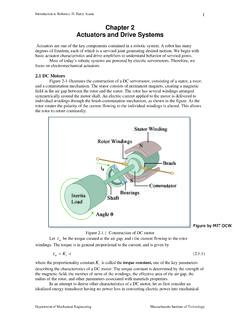Transcription of Understanding Journal Bearings - EDGE
1 Understanding Journal BearingsMalcolm E. Leader, Machinery Dynamics , ColoradoABSTRACTThis paper covers the basic aspects of Journal Bearings including lubrication, design and application. Descriptions ofvarious types of Journal Bearings are presented. Guidance is given for choosing the proper bearing type and keeping yourbearings healthy. A section on do s and don ts gives practical are used to prevent friction between parts during relative movement. In machinery they fall into two primarycategories: anti-friction or rolling element Bearings and hydrodynamic Journal Bearings .
2 The primary function of abearing is to carry load between a rotor and the case with as little wear as possible. This bearing function exists in almostevery occurrence of daily life from the watch on your wrist to the automobile you drive to the disk drive in yourcomputer. In industry, the use of Journal Bearings is specialized for rotating machinery both low and high speed . Thispaper will present an introduction to Journal Bearings and lubrication. Lubrication technology goes hand-in-hand withunderstanding Journal Bearings and is integral to bearing design and they have significant damping fluid film Journal Bearings have a strong impact on the vibration characteristics ofmachinery.
3 The types of machinery we are concerned with range from small high speed spindles to motors, blowers,compressors, fans, and pumps to large turbines and generators to some paper mill rolls and other large slow speed covered here is the topic of Bearings for reciprocating machinery. While some of the same principals apply, enginebearings have special needs and design considerations and deserve a more complete study. Reciprocating machinerybearings tend to be simpler in geometry and much more complicated in application than turbomachinery Bearings .
4 Forexample, the typical turbomachinery Journal bearing consists of a thin layer of babbitt on steel while a connecting rodbearing may have numerous different layers of copper, steel, nickel, or other metals with a thin layer of babbitt on top. This layering is done for fatigue resistance to the pounding loads encountered in such machinery. Engine Bearings areoften required to withstand peak specific loads in excess of 3,000 PSI or about ten times a typical motor or turbinebearing. Reciprocating machines rely primarily on the squeezing of the oil film for load support.
5 WHEN TO USE FLUID FILM BEARINGST here are applications where anti-friction Bearings are the best choice. Commonly, smaller motors, pumps and blowersuse rolling element Bearings . Paper mill rolls often use large specialized spherical roller Bearings . Clearly, anti-frictionbearings are best for these applications. However, once the size of a pump (or fan or motor, etc.) gets large enough andfast enough, a gray area is entered. Here you will still find rolling element Bearings used successfully but as speedsincrease and temperatures rise, rotor dynamics often become a concern and critical speeds are encountered.
6 This is whendamping is required and fluid film Bearings become increasingly necessary. My experience is that turbomachinerydesigners (and users) should consider using fluid film Bearings if running above 3,000 RPM or the machine exceeds 500HP. In my opinion, at 1,000 HP and up, all machines except very special cases should be on Journal Bearings specificallydesigned for that service. There are exceptions of course, and the decision where to apply what type of bearing isultimately done for every machine individually based on good engineering practice and experience.
7 Unfortunately, thisdecision is sometimes based on economics which keeps maintenance engineers and consultants OF FLUID FILM BEARINGSThe primary advantage of a fluid film bearing is often thought of as the lack of contact between rotating parts and thus,infinite life. In a pure sense, this is true, but other complications make this a secondary reason for using these Bearings . During startup there is momentary metal-to-metal contact and foreign material in the lubricant or excessive vibration can limit the life of a fluid film bearing .
8 For these reasons, special care must be taken when selecting and implementing alubrication system and special vibration monitoring techniques must be applied. The most important aspects of the healthand longevity of a fluid film bearing are proper selection, proper installation, proper lubrication, and the alternatinghydrodynamic loads imposed on the bearing surface by relative shaft-to- bearing of the primary advantages of fluid film Bearings are:! Provide damping. Damping is required in order to pass through a critical speed .
9 Damping is also required to suppressinstabilities and subsynchronous vibration.! Able to withstand shock loads and other abuse.! Reduce noise.! Reduce transmitted vibration.! Provide electrical isolation of rotor to ground.! Very long life under normal load conditions.! Wide variety of bearing types for specific applicationsThe lubricant used provides these functions to all Bearings :! Remove heat generated in the bearing .! Flush debris from load disadvantages to fluid film Bearings are:! Higher friction (HP loss) than rolling element type.
10 ! Susceptible to particulate contamination.! Cannot run for any length of time if starved for lubricant such as a lube system failure.! Radial positioning of rotor less of Journal Bearings is also an advantage in many applications when it comes to maintenance. Most fluid filmbearings are split and rotor removal is not required to inspect and replace. While split rolling element Bearings are alsoavailable they are costly and not common. Journal bearing fatigue damage is usually visible at an early stage and allowsfor better diagnostics of failure modes so that corrective action can be taken to prevent Bearings AND BASIC CONCEPTSIn order to illustrate the basic nomenclature, geometry, and introduce the ideas of how fluid film Bearings work, thesimplest bearing called a plain Journal bearing will be examined.

